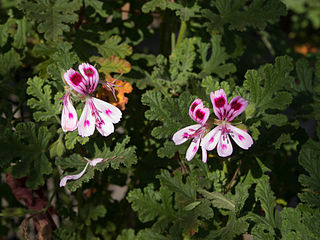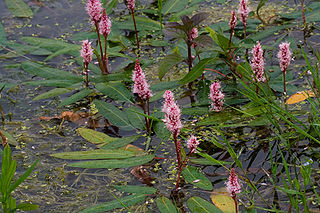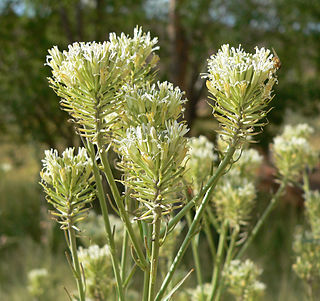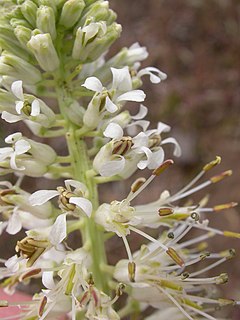
Parsley or garden parsley is a species of flowering plant in the family Apiaceae that is native to the central and eastern Mediterranean region, but has been naturalized elsewhere in Europe, and is widely cultivated as a herb, and a vegetable.

Solanum elaeagnifolium, the silverleaf nightshade or silver-leaved nightshade, is a common native plant to parts of the southwestern USA, and sometimes weed of western North America and also found in South America. Other common names include prairie berry, silverleaf nettle, white horsenettle or silver nightshade. In South Africa it is known as silver-leaf bitter-apple or satansbos. More ambiguous names include "bull-nettle", "horsenettle" and the Spanish "trompillo". The plant is also endemic to the Middle East.

Thelypodium howellii, the Howell's thelypody or Howell's thelypodium, is a rare plant of the Western United States. It is endemic to a relatively small area on the borders of three western States: Oregon, Nevada, and California.

Allium crispum is a species of wild onion known by the common name crinkled onion. It is endemic to California, where it grows along the Central Coast in the Coast Ranges and in the Santa Monica Mountains, often in clays and serpentine soils. It is a perennial herb that is typically found in the foothill woodlands and valley grasslands of California.

Symphyotrichum greatae is a species of flowering plant in the family Asteraceae endemic to California and known by the common name Greata's aster.

Caulanthus cooperi is a species of flowering plant in the family Brassicaceae known by the common name Cooper's wild cabbage. It is native to the southwestern United States and Baja California, where it is a common plant in a number of open, sandy habitats. This annual herb produces a slender, somewhat twisted stem with widely lance-shaped to oblong leaves clasping it. The flower has a rounded or urn-shaped coat of pinkish or pale greenish sepals enclosing light yellow or pale purple petals. The fruit is a straight or curving silique several centimeters long.
Delphinium umbraculorum is a species of larkspur known by the common name umbrella larkspur. However, its epithet does not denote an umbrella. Instead, it describes the habitat of this plant, usually shady and cool places. It is often confused with D. parryii which has similar flowers and D. patens which has similar stems and leaves. It is endemic to California, where it grows in the woodlands of the coastal mountain ranges from Monterey to Ventura Counties. It is a perennial herb producing an erect stem 40 to about 80 centimeters tall. The hairless leaves are located at the base of the plant and along the stem as well. The inflorescence bears several flowers with reflexed dark blue sepals and a spur over a centimeter long. The fruit is between 1 and 2 centimeters long.

Solanum crispum is a species of flowering plant in the family Solanaceae, native to Chile and Peru. Common names include Chilean potato vine, Chilean nightshade, Chilean potato tree and potato vine. Growing to 6 m (20 ft) tall, it is a semi-evergreen, woody-stemmed climbing plant. The small blue fragrant flowers, 2.5 cm in diameter, with prominent yellow ovaries, appear in clusters in summer. They resemble those of the closely related potato. Very small poisonous berries are produced in autumn. The berries start out green, then yellow-orange, and finally purple. The leaves are oval.

Pelargonium quercifolium is a species of geranium known by the common name oakleaf geranium or oak-geranium. It is native to South Africa, and it is a commonly grown ornamental plant. It is in the subgenus pelargonium along with Pelargonium crispum and Pelargonium tomentosum.

Persicaria amphibia is a species of flowering plant in the knotweed family known by several common names, including longroot smartweed, water knotweed, water smartweed, and amphibious bistort. It is native to much of North America, Asia, Europe, and parts of Africa, and it grows elsewhere as an introduced species and sometimes a noxious weed.

Thelypodium is a genus of flowering plants in the mustard family. There are 16 to 20 species, all native to western North America. Thelypody is a common name for plants in this genus.
Thelypodium brachycarpum is a species of flowering plant in the mustard family known by the common names shortpod thelypody and short-podded thelypodium. It is native to parts of northern California and southern Oregon, where it grows in several types of habitat, including alkaline wetlands and serpentine soils.
Thelypodium flexuosum is a species of flowering plant in the mustard family known by the common name nodding thelypody. It is native to the Great Basin and surrounding plateau habitat in the northwestern United States, from California and Nevada to Idaho.

Thelypodium integrifolium is a species of flowering plant in the mustard family known by the common names entireleaved thelypody and foxtail thelypodium. It is native to much of the western United States, including the Great Basin and surrounding plateaus and deserts.

Thelypodium milleflorum is a species of flowering plant in the mustard family known by the common names manyflower thelypody and many-flowered thelypodium. It is native to western North America, particularly the Great Basin and surrounding plateau, desert, and foothill habitat, where it grows in sagebrush and scrub.

Thelypodium stenopetalum is a rare species of flowering plant in the mustard family known by the common names slenderpetal thelypody, slender-petaled thelypodium and slender-petaled mustard. It is endemic to the San Bernardino Mountains of southern California, where it is known from only three or four extant occurrences in moist mountain meadows near Big Bear Lake. Its remaining habitat is considered seriously threatened and the plant is a federally listed endangered species in the United States.
Mimulus hymenophyllus is a species of flowering plant in the lopseed family known by the common names thinsepal monkeyflower and membrane-leaf monkeyflower. It is native to Hells Canyon on the border between Oregon and Idaho in the United States. It has also been reported from Montana.
Thelypodium eucosmum is a species of flowering plant in the mustard family known by the common names arrow-leaf thelypody and world thelypody. It is endemic to Oregon in the United States, where it is known from Grant and Wheeler Counties. There are also historical records of the plant from Baker County.
Thelypodium laxiflorum, the droopflower thelypody, is a plant species native to the southwestern United States. It grows in open, rocky places on slopes and cliff faces, usually in pinyon-juniper woodlands at elevations of 4,900–10,200 feet (1,500–3,100 m). It has been reported from Utah, western Colorado, southern Nevada, northwestern Arizona, and northwestern New Mexico.

Pelargonium crispum is a Pelargonium species native to the Western Cape Province, South Africa. It is in the subgenus Pelargonium along with Pelargonium graveolens and Pelargonium capitatum and Pelargonium tomentosum.













